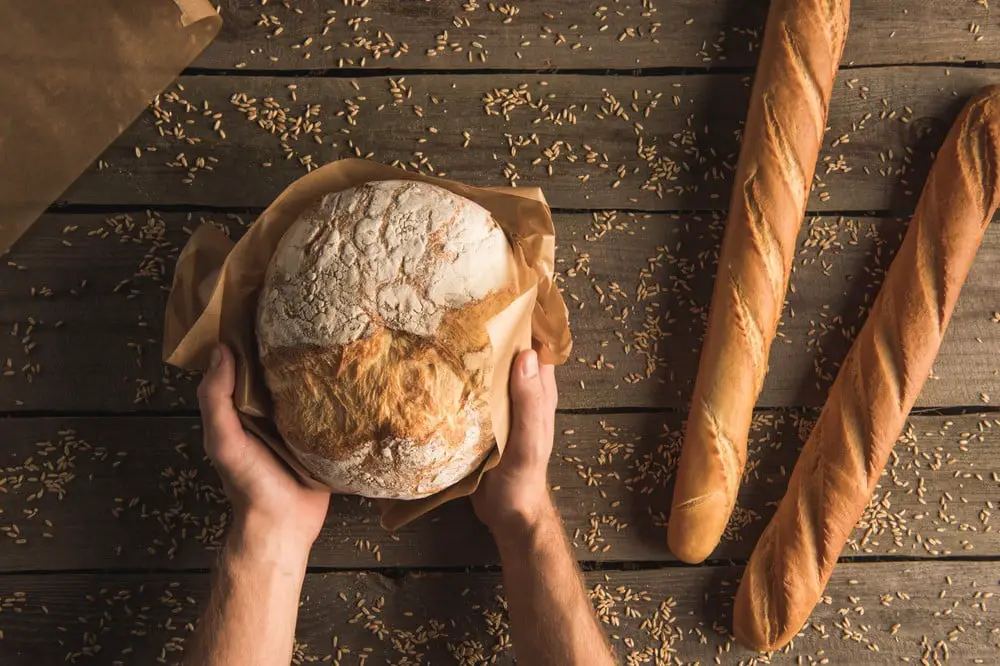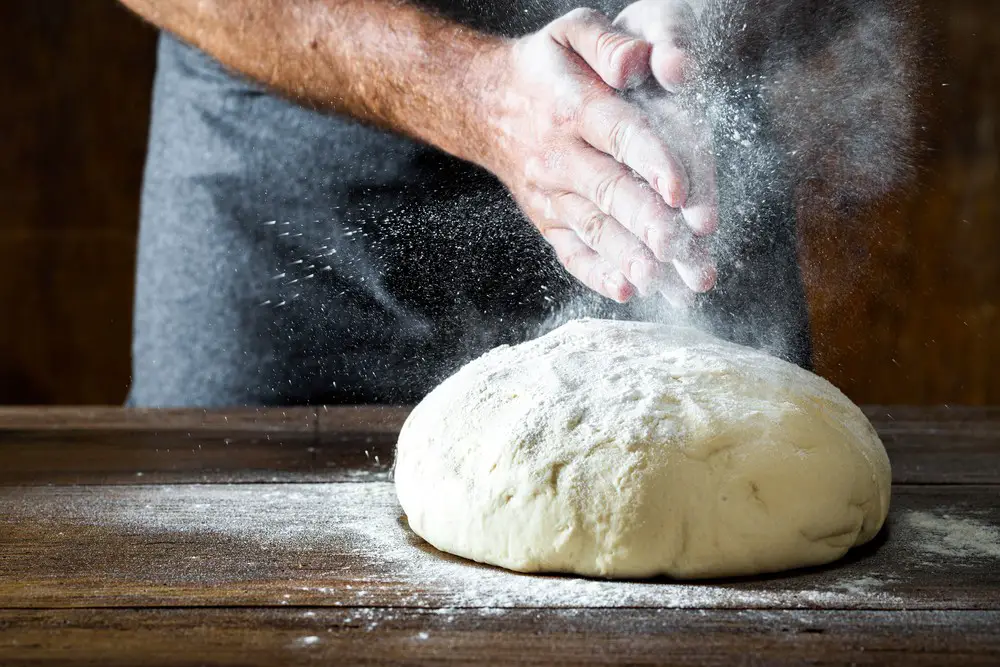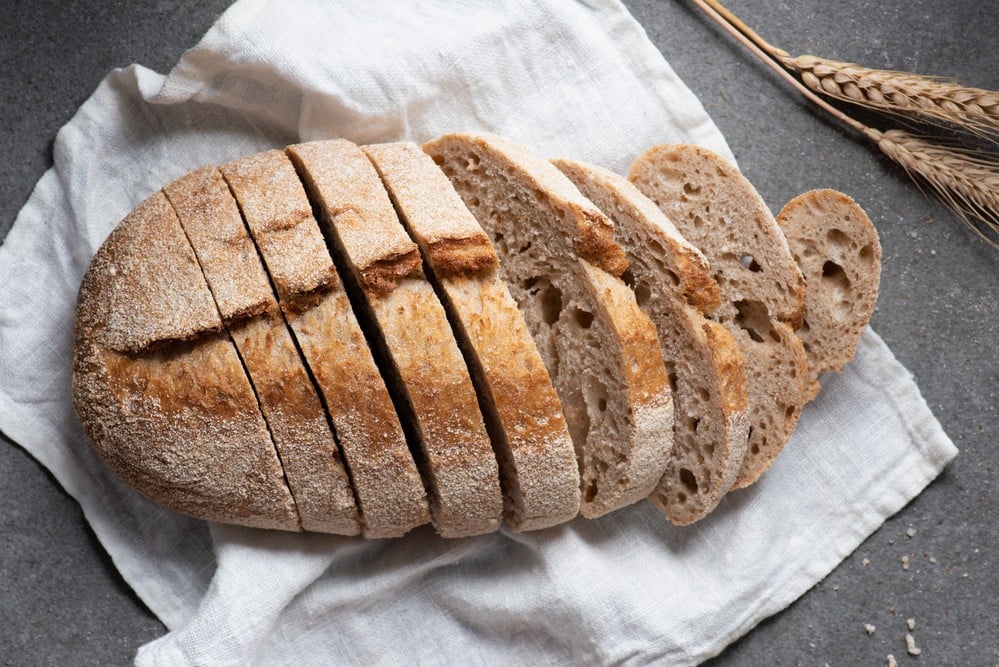Basic bread consists of four main ingredients: flour, salt, water, and yeast, making it vegan. However, some bread recipes call for other ingredients that may have animal origins, like fats, milk, and sugar.
Processed bread often contains additives to improve its texture, flavor, and shelf life, making it unsuitable for vegans. Artisan bread may also contain ingredients unsuitable for vegans, including honey and yogurt.
Even the most common vegan bread, like bagels, baguettes, and sourdough, may contain dairy. Therefore, always check the label to know you are getting vegan bread.
Breadmaking is easy, meaning you can make delicious plant-based loaves at home. Follow this guide for baking the best vegan bread:
Delicious Vegan Bread Recipes
 Vegan bread can consist of a straightforward dough with two ingredients to create a roti, or you can create a hearty health loaf made with wholegrain flour for sandwiches packed with seeds and herbs. There’s no end to the delicious bread you can create with some flour, yeast, and other non-dairy ingredients.
Vegan bread can consist of a straightforward dough with two ingredients to create a roti, or you can create a hearty health loaf made with wholegrain flour for sandwiches packed with seeds and herbs. There’s no end to the delicious bread you can create with some flour, yeast, and other non-dairy ingredients.
These recipes for 30+ of the best vegan bread from the World of Vegan can inspire you to create beautiful crusty bread, bagels, roti, pita bread, and Challah without animal-derived products. When you feel like creating something more challenging, don’t hesitate to try the Pesto Pull-Apart Bread or the very satisfying Vegan Zucchini bread. There’s even a recipe for Rosemary Beer Bread that requires no yeast.
Finally, you will find a recipe for plant-based croissants for a guilt-free breakfast or delicious ideas to serve with dips at dinner parties, like the Almond Flax Crackers and Soft Pretzels.
Simple and Tasty Vegan Bread
There’s nothing like finding a recipe for creating a simple and tasty bread when looking for the best vegan bread. Here’s a recipe from Veggie Society for an Easy Crusty Vegan Bread that uses the ingredients for a pizza dough, meaning it requires only flour, water, and yeast.
The bread is crusty and ideal for making sandwiches or bruschetta or for serving with soups and other foods that require you to “mop up” their deliciousness.
The beauty of this simple vegan bread is that it’s tasty on its own, but that doesn’t mean you can’t add other ingredients to enhance its flavor. Add herbs, pitted olives, or chopped sun-dried tomatoes to the dough without adjusting the other ingredients. About half a cup should do.
Even though the recipe calls for a pizza stone, you can also use a Dutch oven with a lid.
The Best Vegan Bread Recipe
If you are vegan, it doesn’t mean that you can never indulge in fluffy and buttery bread again. One of the best vegan breads for those special moments is the Olive Oil Skillet Bread from Oh My Veggies. Plant-based milk makes for a softer bread with an incredibly fluffy texture.
Instead of olive oil, you can use vegan butter and replace the garlic with any herb you prefer. The recipe uses all-purpose flour, but you can also use half and half with whole meal flour or wholemeal flour.
When baking this bread, follow the steps closely and measure your ingredients for the best results.
Easy Homemade Vegan Bread
 The best vegan bread starts with a basic recipe. Here’s an easy homemade vegan bread recipe that you can customize according to your preferences.
The best vegan bread starts with a basic recipe. Here’s an easy homemade vegan bread recipe that you can customize according to your preferences.
Easy Homemade vegan Bread
Ingredients
- 3 ¼ cup all-purpose flour
- 2 t. dry yeast
- 1 ½ t. sea salt
- 1 ½ cups warm water
- 1 tbsp olive oil
Instructions
- Place the flour with the yeast and salt in a bowl and combine.
- Add the water and olive oil.
- Bring the dough together by stirring with a spoon.
- Knead the dough until smooth, and cover with a clean kitchen towel.
- Allow it to rise for 2 hours or until doubled in size.
- Preheat oven to 450F.
- Dust a baking sheet with flour or brush with oil.
- Lift the edges of the bread and fold them toward the center until you get a ball shape without kneading.
- Place the dough onto the baking dish and let it rise for another 30 minutes.
- Use a serrated knife to make a few cuts on the dough’s surface.
- Bake the loaf for 30 minutes and cool completely before serving.
Substitutes to customize your loaf
- Replace ¼ cup flour with oats.
- You can use gluten-free, whole wheat, or almond flour instead of all-purpose flour.
- Add any seeds or nuts for more texture.
- Add fresh herbs or spices.
- Add a tiny amount of maple syrup or coconut sugar to add some sweetness.
Mouthwatering Vegan Bread Options
 Vegans can indulge in bread as long as it contains plant-based ingredients. One of the biggest problems with shop-bought bread is that the calcium, vitamin D, and sodium caseinate, all leavening or stabilizing ingredients, mostly come from animal sources.
Vegans can indulge in bread as long as it contains plant-based ingredients. One of the biggest problems with shop-bought bread is that the calcium, vitamin D, and sodium caseinate, all leavening or stabilizing ingredients, mostly come from animal sources.
However, there are some excellent vegan bread options if you don’t have time to make your bread. Vegan bread usually includes sourdough, pitta, focaccia, spelt, and rye bread. Bagels, baguettes, ciabattas, and tortillas are also typically vegan. Naan, brioche, cornbread, and Challah are not vegan unless you buy them from a bakery specializing in vegan versions. Therefore, you can find mouthwatering vegan bread options from stores if you closely watch the ingredients list.
On the other hand, try making any of these 17 Easy and Delicious Savory Bread Recipes from Forks over Knives, including a Classic Vegan Cornbread and the Garlic-Jalapeno Naan.
Quick and Easy Vegan Bread Recipes
Most breads need time to prove. However, it doesn’t mean you can’t bake bread at home if you don’t have much time. Many sweet breads like banana bread, muffins, and scones are also quick breads, but the term usually refers to savory bread that doesn’t contain yeast.
Some quick and easy bread examples include soda, beer, and cornbread.
Here’s a recipe from Family Friends Food for the best vegan bread using baking soda (bicarbonate of soda), and it’s dairy-free. Instead of yogurt or buttermilk, the traditional acidic liquid used for soda bread, the recipe calls for vinegar or lemon.
Irresistible Vegan Bread Varieties
Several vegan bread varieties are irresistible. However, intrepid bakers don’t stop trying to recreate the vegan version of most breads, whether they are bakery owners or home bakers.
These are the breads you can usually count on as being vegan:
- Baguettes
- White flour bagels
- White sourdough bread
- Pizza crust
- Pita bread
- Most Indian Flatbreads, except for Naan
- Tortilla
- Ciabatta
- Most rye or pumpernickel bread
Sometimes, buns for hot dogs and hamburgers or muffins might be vegan, but you must check their labels. Finding vegan croissants, Challah, or brioche is challenging because these traditionally contain eggs or milk.
The Ultimate Guide to Vegan Bread Making
Vegan bread making does not differ much from traditional baking. Most bread is vegan to begin with. However, you must replace the eggs or dairy with non-vegan substitutes to try more specialty bread. Here’s the ultimate guide to vegan breadmaking, ensuring you make the best vegan bread.
Ingredient Types and Quantities
It’s necessary to ensure you follow the quantities exactly to achieve a perfect loaf every time. Additionally, you must ensure that you use the type of flour called for in the recipe. Plain baking flour differs from strong baking flour, used primarily in blended bread varieties that require rye or whole meal flour.
If a recipe calls for yeast, check its freshness to ensure it activates. Also, follow the steps for adding the yeast correctly because ingredients like salt or sweeteners can affect its action. If you use a bread machine, fast-acting dry yeast is the best.
Liquid Temperature
Any liquids added to the flour and yeast should be lukewarm. Anything hotter or cooler can hamper the action of the yeast, meaning that it will activate too fast or too slow.
Kneading the Bread
Kneading the dough helps develop the gluten to create the elasticity required for the dough. The trick is to knead long enough to make the dough stretchy but not to toughen the dough with over-kneading. A rule to remember is that 10 minutes is usually enough when kneading by hand. However, for those preferring a food mixer, use the dough hook and reduce the kneading time by half.
Proving
When proving the kneaded dough, it is best kept in a warm room until it has doubled. You can do this by placing the dough in a bowl that you have oiled lightly and then covering it with a clean kitchen cloth. It will prove quicker on a warm day than a colder one, so keep an eye on it. Typically, it will take a bit longer than an hour. Don’t overproof the dough because it will sink again if it fills with too much carbon dioxide, a natural process created by the ingredients. Leave it in a cold room or refrigerator overnight if you want a longer rising time.
Keeping bread Fresh
Once you have baked your bread, you will want to keep it fresh as long as possible. Store your loaf bread bin for a few days, or if you don’t consume a lot of bread, wrap individual slices tightly and freeze for up to six months. Defrost at room temperature and then heat it wrapped in foil in the oven for about 10 minutes on medium heat to restore that freshly baked goodness.
The best vegan bread, like any bread, requires practice. Once you have done this a few times, you will better understand the proper dough elasticity. If your dough is too sticky, don’t get tempted to add more flour immediately. Instead, let it rest for 10 minutes and then knead a bit more. Mixing dough is therapeutic, so give it a try!

